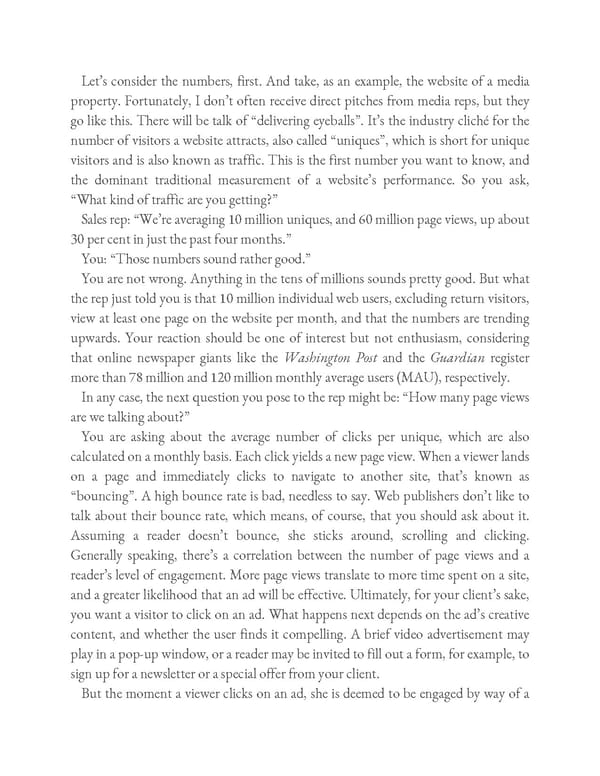Let’s consider the numbers, first. And take, as an example, the website of a media property. Fortunately, I don’t often receive direct pitches from media reps, but they go like this. There will be talk of “delivering eyeballs”. It’s the industry cliché for the number of visitors a website attracts, also called “uniques”, which is short for unique visitors and is also known as traffic. This is the first number you want to know, and the dominant traditional measurement of a website’s performance. So you ask, “What kind of traffic are you getting?” Sales rep: “We’re averaging 10 million uniques, and 60 million page views, up about 30 per cent in just the past four months.” You: “Those numbers sound rather good.” You are not wrong. Anything in the tens of millions sounds pretty good. But what the rep just told you is that 10 million individual web users, excluding return visitors, view at least one page on the website per month, and that the numbers are trending upwards. Your reaction should be one of interest but not enthusiasm, considering that online newspaper giants like the Washington Post and the Guardian register more than 78 million and 120 million monthly average users (MAU), respectively. In any case, the next question you pose to the rep might be: “How many page views are we talking about?” You are asking about the average number of clicks per unique, which are also calculated on a monthly basis. Each click yields a new page view. When a viewer lands on a page and immediately clicks to navigate to another site, that’s known as “bouncing”. A high bounce rate is bad, needless to say. Web publishers don’t like to talk about their bounce rate, which means, of course, that you should ask about it. Assuming a reader doesn’t bounce, she sticks around, scrolling and clicking. Generally speaking, there’s a correlation between the number of page views and a reader’s level of engagement. More page views translate to more time spent on a site, and a greater likelihood that an ad will be effective. Ultimately, for your client’s sake, you want a visitor to click on an ad. What happens next depends on the ad’s creative content, and whether the user finds it compelling. A brief video advertisement may play in a pop-up window, or a reader may be invited to fill out a form, for example, to sign up for a newsletter or a special offer from your client. But the moment a viewer clicks on an ad, she is deemed to be engaged by way of a
 Ogilvy on Advertising in the Digital Age Page 242 Page 244
Ogilvy on Advertising in the Digital Age Page 242 Page 244